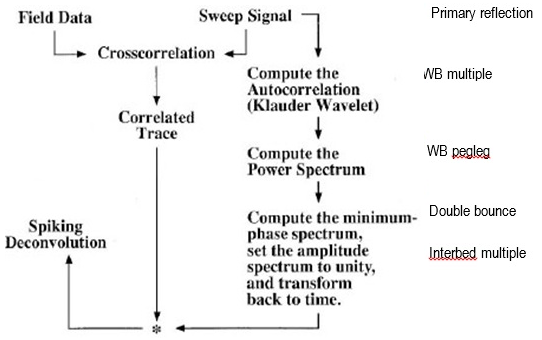Description
Converting the Vibroseis Zero Phase data into Minimum Phase
Cross-Correlation is a measure of similarity of two series f (t)and g (t)as a function of the displacement of one relative to the other.
Let us consider two real functions {\displaystyle f}f and g{\displaystyle g} differing only by an unknown shift along the X-axis. By doing the cross-correlation, we can find how much {\displaystyle g}g must be shifted along the X-axis to make it identical to {\displaystyle f}f . The formula essentially slides the {\displaystyle g}g function along the X-axis, calculating the integral of their product at each position. When the functions match, the value of {\displaystyle (f\star g)}( fx g ) is maximized. This is because when peaks are aligned, they make a large contribution to the integral. Similarly, when troughs align, they also make a positive contribution to the integral because the product of two negative numbers is positive.
The cross-correlation of functions f( t) and g( t) is equivalent to the convolution of f *(− t) and g( t).
{\displaystyle f\star g=f^{*}(-t)*g.} f x g= f* (- t) * g ; where f* denotes the complex conjugate of f
Vibroseis Data Conversion:
Vibroseis source is a long train of sine waves of increasing or decreasing frequencies. Conventional impulsive source like dynamite produces a single discrete impulse for each event, whereas the Vibroseis source will show the event as a pulse train. In an uncorrelated seismic record, the pulse trains for each event overlap and cannot be separated by the human eye. However, after cross-correlation with the input sweep, each event should appear as a synthetic pulse which has the shape of the auto-correlation of the sweep.
Following are the advantages …
1.Since we know the form of the source signal, we can easily remove the back ground noise from the data using the source signal
2.We know the Vibroseis sweep frequency band, anything outside the frequency band limit of the sweep can be considered as a noise and that can be filtered out.

Figure 1. Schematic diagram of Vibroseis data Cross Correlation and Deconvolution (Image courtesy: SEG Wiki)
Convert to Min Phase (Default False)
Decon Operator
User recommendations:
In the Output data tab, users can save the Klauder Wavelet, Min Phase Decon Operator, Modeled Sweep Signal etc.
In the Output data tab, users can save the Klauder Wavelet, Min Phase Decon Operator, Modeled Sweep Signal etc.